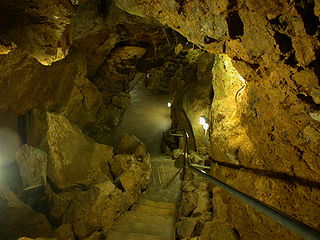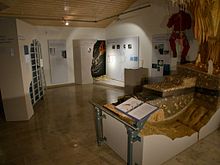Laichinger deep cave
| Laichinger deep cave
|
||
|---|---|---|
|
Small hall, lowest point of the guide way at 55 m depth |
||
| Location: | Laichingen | |
| Height : | 780 m above sea level NN | |
|
Geographic location: |
48 ° 28 '43 " N , 9 ° 41' 31" E | |
|
|
||
| Geology: | Lime and dolomite | |
| Type: | Shaft cave | |
| Discovery: | 1892 | |
| Overall length: | 1348 m | |
| Level difference: | 86 m | |
| Length of the show cave area: |
330 m | |
| Average annual number of visitors: | 27,600 (2015-2019) | |
| Current visitors: | 26,176 (2019) | |
| Website: | official website | |
The Laichinger Tiefenhöhle is the only shaft cave in Germany that has been converted into a show cave . You descend to 55 meters below the surface of the earth, making it one of the deepest show caves in Germany.
location
The Laichinger Tiefenhöhle is located in dolomite , which was quarried as sand on the surface . During this activity, the cave was discovered by the Laichingen sand digger Johann Georg Mack in 1892. The cave was explored shortly afterwards and measured by the architect Paul Kienzle as early as 1894 . The many shafts were equipped with self-made wooden ladders due to a lack of suitable climbing equipment. The deepest point of 80 meters was discovered as early as 1906. During this expedition, named after its leader Kaulfuss , the cave was also measured again. In the 1930s it was expanded into a show cave and illuminated electrically. There has been an artificial exit shaft since 1975, so that the cave is now exited through a second exit.
The main part of the cave is located in the mass limestone, a massive and unlayered limestone that was formed as a reef . In many places you can see the sponges that built up the reef. The cave has hardly any stalactites , but is geologically very interesting, for example due to the water level marks , solution pools and carts . There are larger deposits of pearl sinter . The cave has a total length of about 1300 meters and a maximum depth of about 80 meters. The guide way is 350 meters long and leads to a depth of 55 meters.
The Laichinger Tiefenhöhle is located in the catchment area of the Blautopf . This was proven by dyeing tests. A duration of 36 hours was determined for the 15 kilometers as the crow flies. This very short time corresponds to a high flow velocity, which in turn suggests a connection through a deeper cave floor. The water flows about 180 meters below the surface of the earth, on the karst water table . The other end of this cave system is the Blautopfhöhle , where great research successes have been made in the last few years, especially in 2007. The main course roughly points towards Laichingen. Should a cave actually extend to Laichingen, the Blautopfhöhle would be one of the longest cave systems in Germany with a passage length of more than 15 kilometers. This incentive also results in a systematic search for alternative access to the lower floor in various caves in the Blaubeurer Alb : deep cave, factory shaft and RÜB shaft. So far, however, without success.
Entering the deep cave requires appropriate clothing, especially good shoes, as the guide path has several steep iron stairs. A warm jacket is also strongly recommended, the cave has a temperature of 8 ° C all year round. In summer clothes it quickly gets uncomfortably cool. At the entrance , visitors are given gaiters to protect their trouser legs from soiling with cave clay .
Speleological Museum
There has been a speleological museum in the entrance building since 2002 . Various aspects of caving are presented here. From the cave formation to cave contents such as stalactites, animal bones and archaeological artefacts to inspection technology and cave surveying. Large models illustrate the typical cave types in the Swabian Alb , the sedimentation and the skeleton of a cave bear ( Ursus spelaeus ) in an upright posture.
Since June 2006, the cave museum has also been one of 26 information points of the UNESCO Geopark Swabian Alb .
Infrastructure
The deep cave is located about 1.5 kilometers south of Laichingen and has its own parking lot. There is a beer garden at the cave entrance, some of which is even covered. Drinks, ice cream and small dishes are available in the cave rest house. In the rest house and beer garden, guests are welcome to bring their own snacks with them and consume them, as long as the drinks are bought from the rest house. This regulation is widely known from Bavarian beer gardens. For children, the forest and the playground set up by the community are the highlight, there are several fire pits and even a barbecue hut.
Other karst phenomena
There are various karst phenomena around Laichingen, which are combined into an approximately twelve kilometer long karst hiking trail. Important stops are a cave ruin - the Hohle Stein - and several artificial and natural shells , these are water-filled hollow forms that are either sinkholes or volcanic craters filled with clay . The starting point is the parking lot of the deep cave. Information is available on the website and in a leaflet available at the cash desk.
About one kilometer from the deep cave is the Vogts Grub , one of the largest sinkholes in the middle Alb. It can be easily reached from the cave via dirt roads.
See also
literature
- Hans Binder, Anke Luz, Hans Martin Luz: Show caves in Germany . Aegis Verlag, Ulm 1993, ISBN 3-87005-040-3 , pp. 91-93.



